Swallowtail Butterflies: Everything You Need to Know
Updated: May 16, 2023
Big, vibrant and abundant swallowtail butterflies bring a flurry of eye-catching activity to backyards across the United States.
All About the Swallowtail Butterfly Family
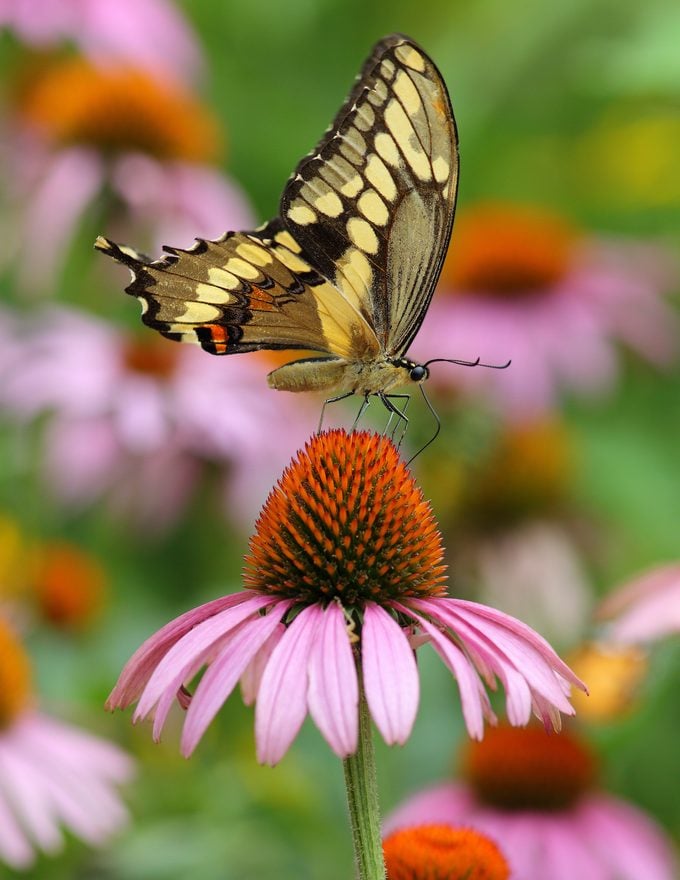
Swooping over meadows and pausing on blooms, swallowtails draw attention with their large size and striking colors. They get their name from the extended tails on their hindwings, a feature that makes them more buoyant in flight but that, interestingly, not all swallowtails possess. It’s a diverse family, with more than 500 swallowtail butterfly species fluttering over six continents. Most are tropical, but about 25 kinds are found regularly in the United States and Canada. No matter where you live, you can see these butterflies during the warmer months of the year.
Discover the top 10 swallowtail host plants and flowers to grow.
Swallowtails Are Aptly Named
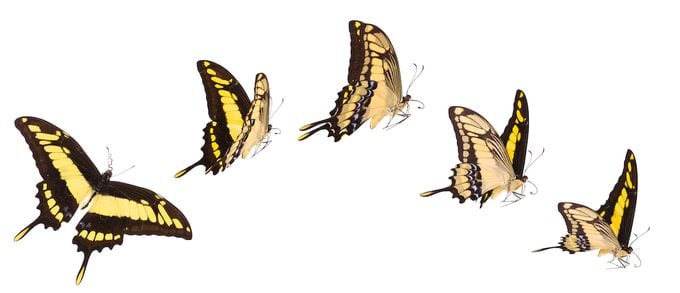
Many swallowtails have colorful names that help with identification. For example, the tiger group is bright yellow with narrow black stripes. Three species in this group—eastern, western and Canadian—are separated by range, but among the three of them, they’re found everywhere from Florida and southern California to northern Canada and Alaska.
A similar flier with a bit of a fancier shape, the two-tailed swallowtail, is a very common sight in the West. The zebra swallowtail of eastern forests is our personal choice for the most beautiful butterfly. It’s striped black and white, as the name suggests, and has red accents. Very long tails on the hindwings give it an especially graceful, flowing flight.
However, the giant swallowtail is not the largest member of the family as its name implies—some eastern tigers are actually larger—though the giant is still big enough to be impressive. Giant swallowtails live mainly in southern states, but a few wander far north every summer, reaching southern Canada.
Swallowtail Caterpillars
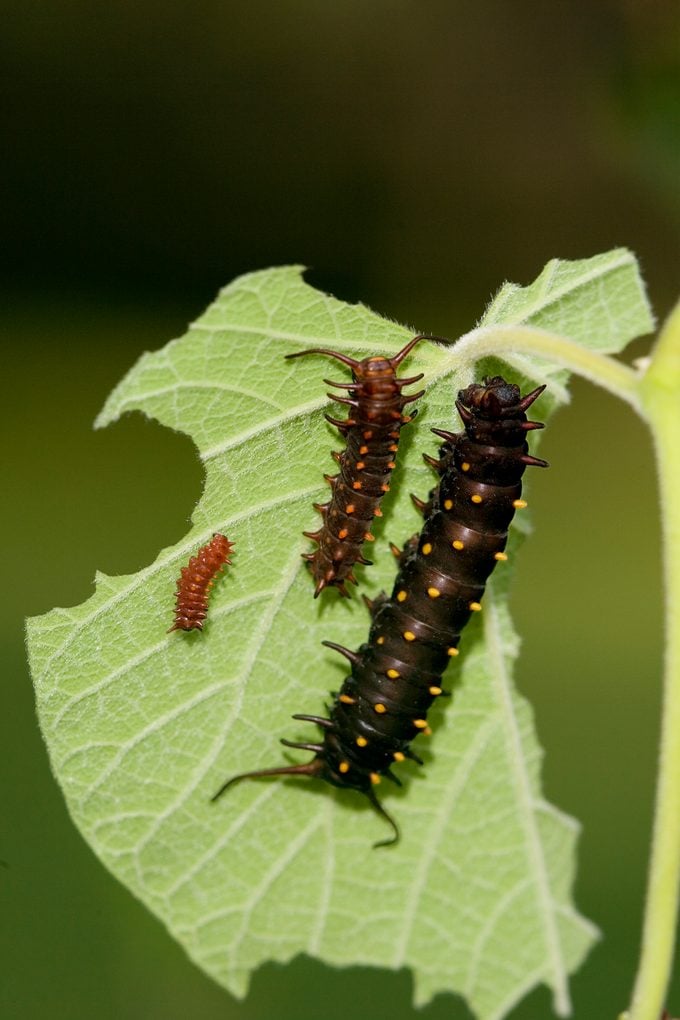
Swallowtails are large butterflies, so naturally their caterpillars, or larvae, grow to be pretty good-sized. Many have beautiful or strange color patterns.
The giant swallowtail caterpillar has a smeary black and white pattern, and when it’s still small, it’s easy to miss because it looks like bird droppings. The pipevine caterpillar is dark reddish to black and covered with orange spikes.
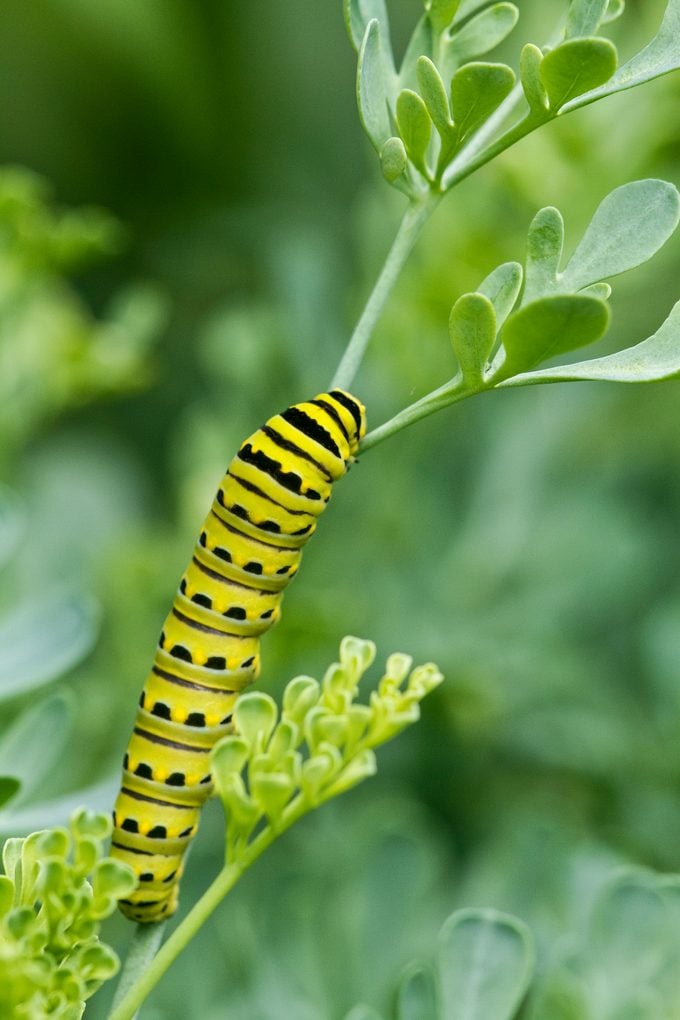
In some species, such as the tiger and spicebush swallowtails, the caterpillar is green with two large round spots on the swollen front end that look like the eyes of a snake. This may startle birds enough to leave the larvae alone.
Swallowtail larvae have one more trick. They all have a Y-shaped organ called an osmeterium tucked into a cavity just behind their head. If the caterpillar is threatened, the fleshy, orange osmeterium pops out. It looks a little like the forked tongue of a snake, and it carries a smell that’s foul enough to repel some predators.
What does a monarch caterpillar and chrysalis look like?
Models and Mimics
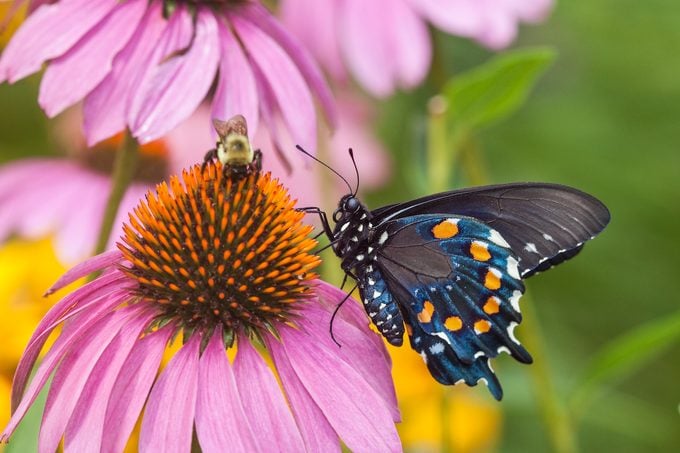
Monarch butterflies are famous for having caterpillars that eat milkweed. This habit allows them to take in chemicals that make even the adults taste bad to predators. The pipevine swallowtail, common in southern states, uses the same chemical protection. Its larvae feed on pipevine plants, and bitter compounds from those plants stay in the adults. When a bird grabs a pipevine swallowtail, it gets a mouthful of bad taste and learns to look for other caterpillars for food.
Predators pass up several other butterfly species simply because they look similar to pipevines. This includes the spicebush and others—as well as some completely unrelated butterflies, like the red-spotted purple.
Some female eastern tiger swallowtails may use this defense. They can either be yellow, like the males of their species, or dark to mimic the bitter pipevine swallowtail. The dark form is found mainly in the South, where such mimicry is more likely to be effective because birds there have experienced the toxic taste of the pipevine.
Grow the Right Plants for Swallowtails
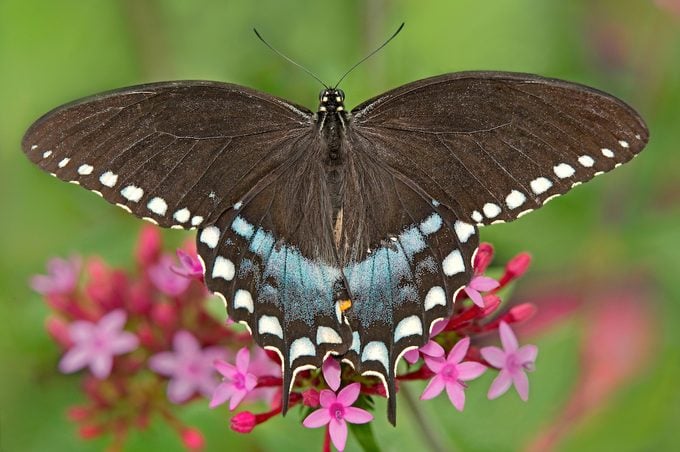
Swallowtails are attracted to a wide variety of blooms for nectar. They may visit any garden, but to keep them coming around, the most important thing is to provide host plants for their caterpillars.
Many larvae live on and eat leaves of only certain trees and shrubs. Zebra swallowtail caterpillars mainly feed on pawpaw trees. Spicebush swallowtails favor the spicebush and sassafras. Eastern tiger swallowtails go for several kinds of trees, including ash, wild cherry and tulip tree.
Canadian tiger swallowtails can’t eat tulip tree leaves, instead favoring aspen and birch. Giant swallowtail larvae feed on various plants in the citrus family. With so many choosy appetites, it’s a good idea to research which swallowtails live in your area before deciding on what garden plants to try.
The easiest members of the family to attract are black swallowtails in the East and Southwest, and anise swallowtails in the West. The beautifully colored, striped and spotted caterpillars of these common butterflies feed on many plants in the parsley family, so plant more to share. Then enjoy watching the swallowtail caterpillars grow, knowing you’re supporting local butterfly populations.
Common Swallowtail Butterfly Types to Know
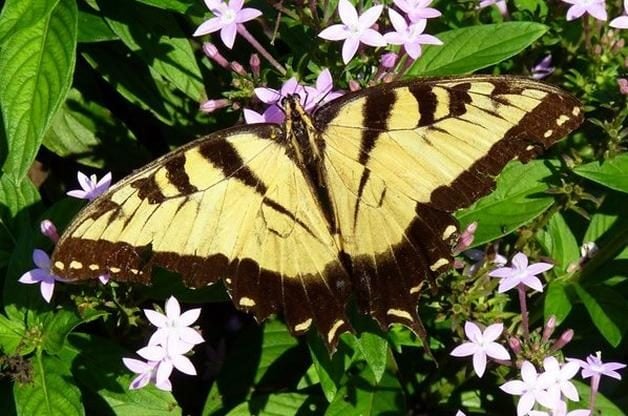
1. Tiger Swallowtail
A tiger swallowtail flying against the blue sky is a lovely sight. Though they’re frequently found in wooded areas (they generally host on trees), they’re common in the flower garden, too. There are a variety of species around the country, all of which look fairly similar.
In the east, look for the Eastern tiger swallowtail, Canadian tiger swallowtail, and Appalachian tiger swallowtail. Out west, you’ll find the Western tiger swallowtail and the pale swallowtail. In some areas, females are black with tiger stripes only faintly visible in the bright sun.
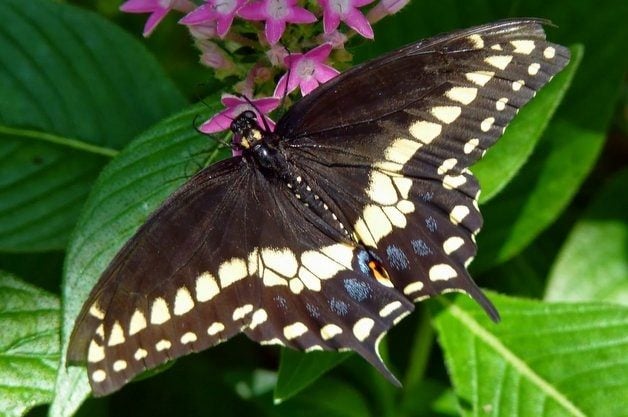
2. Black Swallowtail
Black swallowtail larvae are often known as “parsley caterpillars” since that’s one of their most common host plants. They also host on dill, fennel, Queen Anne’s lace, and common rue. This swallowtail butterfly is found in much of the U.S. with the exception of the northwest. Females have a band of iridescent blue on their hindwings, while males have a band of yellow instead.
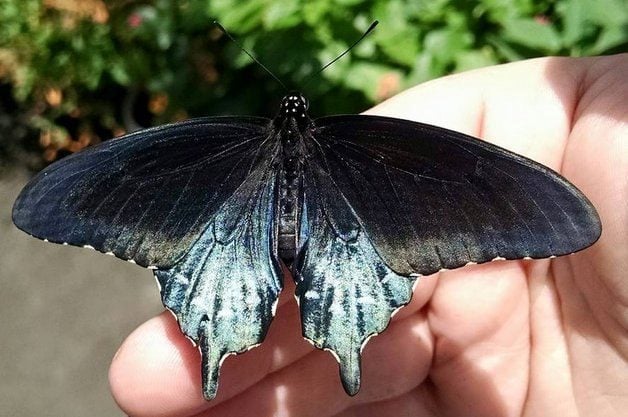
3. Pipevine Swallowtail
Pipevine swallowtails are found throughout the eastern U.S. and through the southwest to California. They host on pipevines (Aristolochia sp), as their name indicates. Males are a beautiful iridescent blue. Females are a duller black color. They lay bright red eggs in groups on their host plants, and their caterpillars are extremely fast moving.
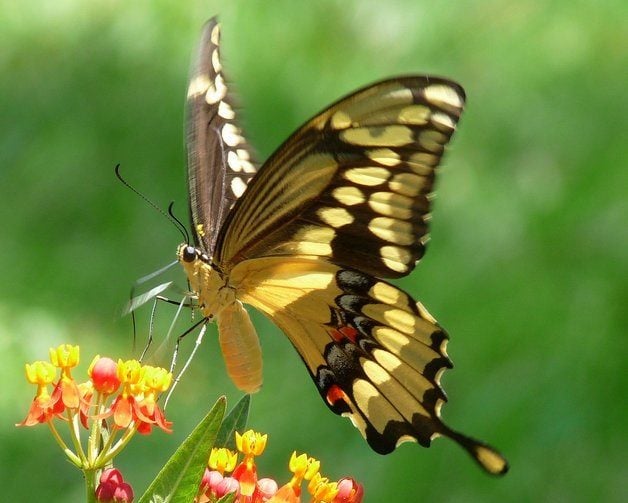
4. Giant Swallowtail
The giant swallowtail is the largest swallowtail butterfly in the U.S., with a wingspan of up to 6 inches. This butterfly is an excellent example of countershading, being dark on the topsides of their wings and bright yellow on the bottom. This gives them better camouflage against predators. Giant swallowtails lay eggs on citrus trees, as well as prickly ash and common rue. Their caterpillars also display excellent camouflage, looking exactly like fresh bird droppings.
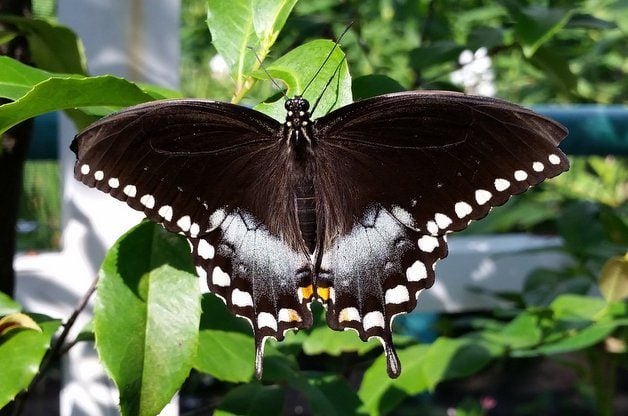
5. Spicebush Swallowtail
Spicebush swallowtails are found in the eastern half of the country. Their range overlaps with the extremely similar-looking black swallowtail. You can easily tell a spicebush swallowtail from a black swallowtail if you can get a close look. Black swallowtails have a tiny black dot in the orange circle at the base of their lower wing, while spicebush swallowtails do not.
As the name might suggest, this swallowtail butterfly hosts on spicebush, as well as red bay, camphor, sweet bay, and tulip tree. Their caterpillars are leaf-rollers with large eyespots to scare off predators.
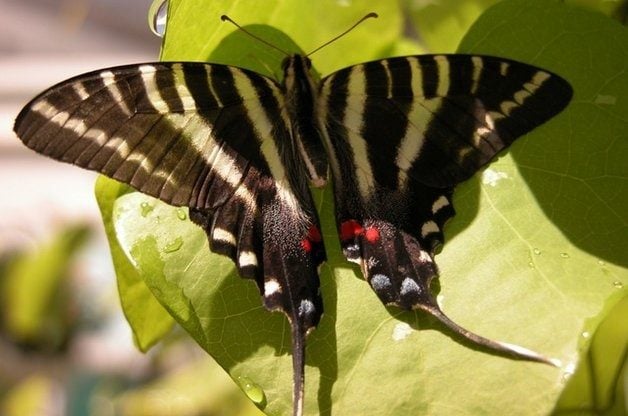
6. Zebra Swallowtail
Probably the most spectacular of the swallowtail butterflies, the zebra swallowtail flies in the eastern half of the country. However, it is one of the rarest swallowtail butterflies. It’s usually only found in great numbers where its host plant, pawpaw (Asimina sp.) also thrives. The long tails and distinctive zebra striping make this butterfly a stunning sight.
Mountain Marvels
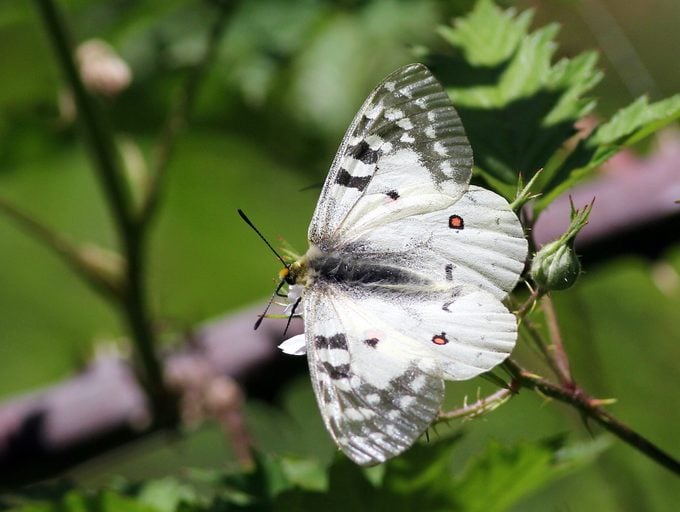
Another branch of the family is usually found in high altitudes. A unique subset of the swallowtail family, the parnassians are tail-less white butterflies with black marks and red spots. Most kinds live in the mountains of Asia and Europe. But five species are found in western North America, mostly in high mountains or on northern tundra. In the cool climates of the mountains, parnassians usually fly slow and close to the ground.
Next, meet the lovely American lady butterfly.
